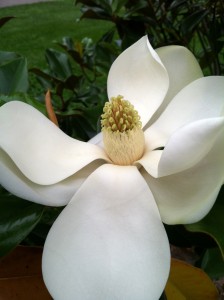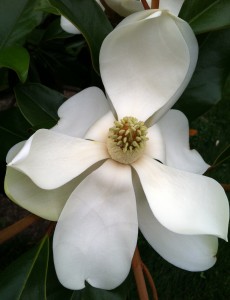Southern Magnolias
Posted in Gardens and Collections on July 9 2013, by Sonia Uyterhoeven
Sonia Uyterhoeven is the NYBG‘s Gardener for Public Education.
 This morning when I was walking to my office I noticed that the southern magnolia, Bracken’s Brown Beauty (Magnolia grandiflora ‘Bracken’s Brown Beauty’) was in bloom. My first impulse was the right one—to go up to the voluptuous, velvety petals, shoo the bees and other insects away, and stick my nose into it.
This morning when I was walking to my office I noticed that the southern magnolia, Bracken’s Brown Beauty (Magnolia grandiflora ‘Bracken’s Brown Beauty’) was in bloom. My first impulse was the right one—to go up to the voluptuous, velvety petals, shoo the bees and other insects away, and stick my nose into it.
Not all magnolias have fragrances, but many do, and it is always worth investigating. ‘Bracken’s Brown Beauty’ has a distinctive lemon dishwashing detergent smell to it. It’s not a fragrance that is going to have you traveling from miles away to visit the flower, but it is nonetheless pleasant and worth a sniff or two.
Honestly, the fragrance is just a poor excuse to get close to the magnificent flower. The flower is substantial at 4-6” wide, with petals that are reminiscent of the undulating wings of a dove. Botanically speaking, since the petals and the sepals look so similar in a magnolia, they are classified as tepals. Sepals for the botanically less-inclined are the outer layer of the flower—in trees they are generally green leaf-like structures that protect the flower when it is in bud and then support it when in bloom.
Inside the tepals the reproductive center of the magnolia sits up high and looks like a small pineapple or pine cone. From the photo you can clearly see the stamens (the male part of the flower that supplies pollen) like white matchsticks clustered around the carpels or the female parts of the flower. The curly-cue structures that you see on top are stigmas that catch the pollen which is then transported down to the ovaries below. Once fertilized, the anthers drop and the cone-like receptacle forms bright red seeds.
Southern magnolias have leathery evergreen foliage. Most southern magnolias are hardy only to zone 7, but ‘Bracken’s Brown Beauty’ is a resilient cultivar that is hardy to zone 5b. It grows 30 feet tall and has a pyramidal, narrow shape. Its foliage is glossy green on top and a soft fuzzy brown underneath, giving it a nice bi-colored appearance. It flowers in June and July in the New York area. Noteworthy characteristics of this magnolia are its deer resistance, salt tolerance, and evergreen foliage that provides winter interest.
 When we first planted these magnolias several years ago, it was during a spring with heavy rains and high winds. The ground was supersaturated when we planted them. Before they had time to establish a good root system, we experienced a heavy wind storm and the three specimens toppled over like a stack of dominoes.
When we first planted these magnolias several years ago, it was during a spring with heavy rains and high winds. The ground was supersaturated when we planted them. Before they had time to establish a good root system, we experienced a heavy wind storm and the three specimens toppled over like a stack of dominoes.
We went out the next day, replanted them, staked them, and they have been thriving ever since. Despite their ominous start, these southern beauties are thriving in the garden, so come stick your noses in them when you visit—you’ll find them just to the side of the Mosholu Gate entrance.


These flowers caught my attention too, they’re stunners:
http://www.flickr.com/photos/wundoroo/9169711581/